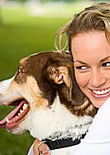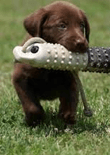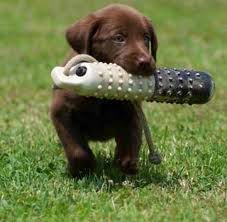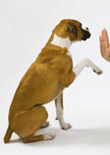
Obedience Training For Dogs in 8 Weeks
By Sally Gutteridge | Posts , Training
 Obedience training can sometimes be overwhelming when you get a new dog. Most people think that they can train their dog themselves and some are successful while others struggle. But in reality, everyone can have a well behaved and loving family dog in only 8 short weeks.
Obedience training can sometimes be overwhelming when you get a new dog. Most people think that they can train their dog themselves and some are successful while others struggle. But in reality, everyone can have a well behaved and loving family dog in only 8 short weeks.
The problem I see when people train their dog themselves, is that they unknowingly reward bad behaviors; their timing is off, and they sometimes discipline the dog unfairly.
But at last! Here are some 3 free strategies to get you started on the right path to training your dog.
- Proper Timing. Reward or discipline your dog at the time of the good or bad behavior, not after long periods. Why? Because dogs learn in the moment. Even a minute after the fact is too late, they will not know why they are getting rewarded or punished. The optimal time for a reward or a punishment must be one second after the behavior.
- Attend Professional Obedience Training for Dogs Sessions or Classes. This will provide you with a structured training program that will make your training more efficient and rewarding for both you and your dog. I understand that some people may not be able to afford dog training classes, but there are always other options. Look for a local club in your neighborhood who may be training dogs recreationally, or look on Craigslist for a new trainer who is just starting their business.
- Train Your Dog Daily. Obedience training for dogs is sometimes tricky because most people think that they have to set aside too much time to do this every day; however my experience shows 20 minutes a day is more than sufficient for a well-behaved dog. In fact, I only train my dogs 5 – 10 minutes at a time a few times each day.
Using these strategies will ensure that you have a well-behaved dog while investing minimum amount of time and money. Here at the Dog Trick Academy, our obedience training for dogs program will provide you with proven strategies to help you train your dog to not only obey you, but also connect and build a strong relationship with them that will last a lifetime.


 If you have just brought a new puppy home for the first time, it may be tempting to cuddle, spoil, and shower your adorable puppy with affection. But just as important as love and affection, is taking the time to train your puppy from a young age so that he can learn good behaviors that will stick with him for the rest of his life.
If you have just brought a new puppy home for the first time, it may be tempting to cuddle, spoil, and shower your adorable puppy with affection. But just as important as love and affection, is taking the time to train your puppy from a young age so that he can learn good behaviors that will stick with him for the rest of his life.
 The best dog training tactic to use with your puppy or adult dog is positive reinforcement and motivation. Once your dog begins to understand that he will be rewarded for obedience and good behavior, he will instinctively want to please you to earn praise or another treat.
The best dog training tactic to use with your puppy or adult dog is positive reinforcement and motivation. Once your dog begins to understand that he will be rewarded for obedience and good behavior, he will instinctively want to please you to earn praise or another treat.